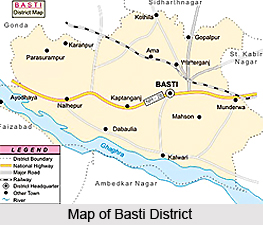 Basti District is one of the administrative districts of Uttar Pradesh. Basti town is the administrative headquarters of this district. Total population of Basti District as per 2001 Census is 2,068,922 persons, out which male population is 1,079,971 and female population is 988,951. Population density of the district is 682 persons per sq km. According to 2001 Census, literacy rate of the district is around 54.28 percent (male literacy rate is 68.16 percent and female literacy rate is 39 percent.
Basti District is one of the administrative districts of Uttar Pradesh. Basti town is the administrative headquarters of this district. Total population of Basti District as per 2001 Census is 2,068,922 persons, out which male population is 1,079,971 and female population is 988,951. Population density of the district is 682 persons per sq km. According to 2001 Census, literacy rate of the district is around 54.28 percent (male literacy rate is 68.16 percent and female literacy rate is 39 percent.
Location of Basti District
Basti District lies between the parallels of 26 degree 23 minutes and 27 degree 30 minutes north latitude and 82 degree 17 and 83 degree 20 minutes east longitude. Its maximum length from north to south is about 75 km and breadth from east to west about 70 kms. The district lies between newly created Sant Kabir Nagar District on its east and Gonda on its west, in the south Ghaghara River separates it from Faizabad and newly created district named Ambedkar Nagar. While on the north it is bounded by district Siddharthnagar.
History of Basti District
In the past, this region was extensively remote and was mostly covered with forests. Early history of Basti District is not clear but eventually the area became inhabitant. However, it is not very clear how the district came to known by its present name. Gradually, the region was made the Tehsil headquarter and then the district headquarters in the year 1865 when the new Basti District was formed. Since then it has steadily grow both in population and in general importance.
Geography of Basti District
Topographically, Basti District is divided into several distinct tracts like the low valley of the Ghaghara in the south, the central upland between the Kuwana River and the Rapti River; and lastly, the low paddy zone between river Rapti and Nepal boundary. Basti District includes a moderate climate. It is comparatively calmer than the other districts of the state. A seasonal year is divided into winter season (from mid-November to February), summer season (from March till mid June), south-west monsoon season (from mid-June to the end of September) and lastly post monsoon or transition season (from October to mid-November). Average annual rainfall in Basti District is 1166 mm.
Basti District is rich in flora and fauna. Though the district is no longer rich in timber, it can still be described as well-wooded, owing to the numerous clumps of mango, mahua, Sal and bamboo.






